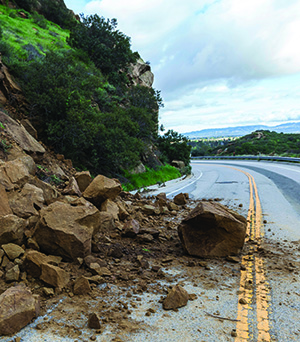
Predicting near real-time post-fire debris flows along ODOT corridors.
Landslides can have major environmental, societal and economic impacts — and they often occur in conjunction with extreme events, like heavy precipitation, wildfires and earthquakes.
In mountainous, forested terrain across the West, like in Oregon, shallow landslides are a persistent hazard that can impact aquatic ecosystems and the structure of a forest. But despite the prevalence of this hazard, much remains unknown about the interplay between a landslide, the forest structure, and events like heavy rainfall and wildfires.
Richardson Chair in Forest Engineering, Resources and Management, Ben Leshchinsky is leading a team to learn more about landslides in forested environments — which will help provide new insights into how the dynamics of a forest and its vegetation affect the size and rate of landslides. This group is developing models to predict the susceptibility of future slides in mountainous, forested regions and evaluate the importance of forest vegetation on landslide size and rate. These efforts will provide insights into how vegetation may influence shallow landslides, particularly following wildfire.
The team is using climate monitoring stations, remote sensing and field testing of burned and live roots across the Cascades to better understand how factors like slope vegetation influence the likelihood of landslides and debris flows, as well as the timing at which these hazards are critical. Understanding more about slope stability and susceptibility will also provide valuable insights into how extreme events like heavy rainfall might initiate slope failure — especially how forests and their associated root strength may control post-wildfire mass movements.
Oregon State University researchers are collaborating with many agencies on this project including the Oregon Department of Forestry, the United States Forest Service, the United States Geological Survey, Oregon Department of Geology and Mineral Industries, and Oregon Department of Transportation.
A version of this story appeared in the 2021-2022 College of Forestry Biennial Report.


Intriguing research by Ben Leshchinsky and team on the nexus between forest ecology and landslide susceptibility, especially post-wildfires.